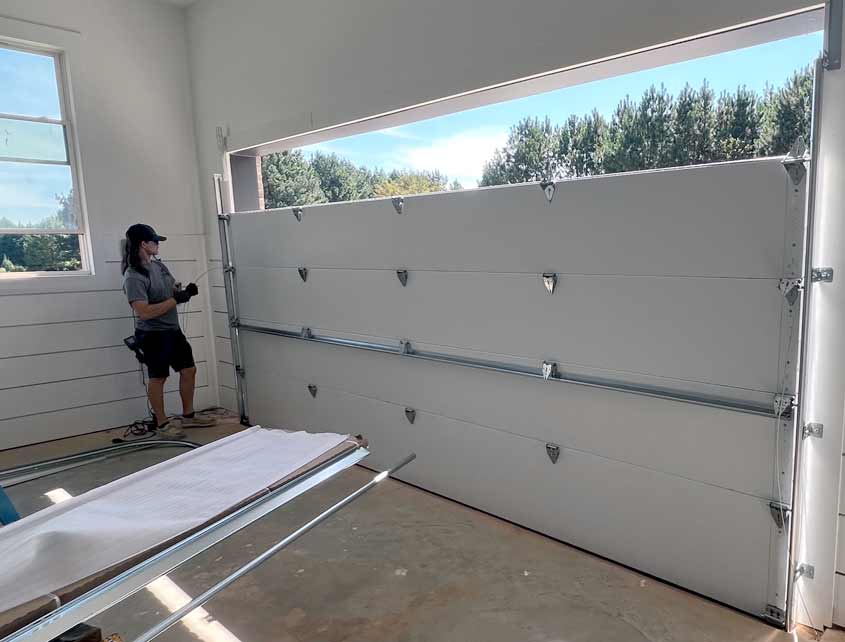Common Garage Door Troubles and How to Deal with Them
Garage doors are vital for both safety and benefit, yet they typically present a variety of usual concerns that can irritate property owners. While some issues might show up simple to settle, others may require an extra nuanced understanding of garage door auto mechanics.
Noisy Garage Door Operation
A loud garage door operation can be a significant source of aggravation for home owners, commonly suggesting underlying mechanical issues. Such disturbances may originate from numerous reasons, including damaged rollers, loose equipment, or insufficient lubrication. Recognizing the source of the noise is critical for efficient resolution.
One common reason of excessive sound is the presence of corroded or worn-out rollers. Gradually, these elements can wear away, causing grinding or squealing noises as the door actions. Routine examination and substitute of these rollers can significantly minimize sound levels. In addition, loose bolts or screws in the door system can develop rattling noises during operation. Tightening up these bolts guarantees an extra stable and quieter motion.
One more adding factor is insufficient lubrication of the door's relocating components. Applying a high-grade lube to the tracks, springtimes, and rollers can substantially diminish friction and noise. House owners need to execute this upkeep occasionally to keep optimum performance.
Finally, the garage door opener may likewise produce sound as a result of its age or mechanical issues. If the noise persists despite dealing with other aspects, speaking with an expert for a comprehensive evaluation and prospective repair service might be needed.
Door Won't Open or Close
Experiencing a garage door that won't open or shut can be unbelievably frustrating and often signals a malfunction within the system. A number of elements can add to this issue, and identifying the origin reason is necessary for effective resolution.

Next, check the safety sensing units situated at the base of the door. These sensors can end up being misaligned or obstructed by particles, preventing the door from operating correctly. Tidy the sensors with a soft towel and guarantee they are lined up.
In addition, the garage door's internal elements should be examined. Concerns such as a broken spring, damaged rollers, or a harmed opener can hinder motion. If any kind of parts seem damaged, it might be suggested to seek advice from a specialist for repairs.
Misaligned Tracks
(Quick and Easy)Misaligned tracks can drastically interfere with the smooth procedure of a garage door, causing functional failings such as unequal motion or complete immobilization. This concern generally develops due to a selection of factors, including deterioration, accidental effects, or improper installation. When the tracks are misaligned, the rollers can not move freely, which not just strains the electric motor but likewise postures security dangers.
If you notice any kind of inconsistencies, it is essential to resolve the problem promptly. Meticulously touch the track back right into its appropriate placement utilizing a rubber club or a similar device, ensuring it is straight and degree.
Once the alignment is corrected, retighten the screws to protect the track. For a more long-term solution, think about enhancing the tracks with extra braces. Regular upkeep, consisting of cleaning the tracks and making certain rollers are in excellent problem, can stop future misalignments. By resolving misaligned tracks without delay, you can restore the functionality of your garage door and boost its long life.
Broken Springs
Among the different parts of a garage door system, busted springs are one of the most typical concerns that can dramatically impede its functionality. Garage door springs are important for stabilizing the weight of the door, permitting for smooth opening and closing. When a springtime breaks, it can bring about a door that is hard to run or, in some cases, completely inoperable.
There are two primary kinds of springtimes: torsion springtimes, which are placed over the door, and expansion springs, found on either side. Signs of a broken springtime consist of a door that will not open up, a noticeable void in the springtime, or a loud sound throughout procedure. Attempting to operate a garage door with a broken spring can cause more damages to the door or the opener.
Repairing broken springs is not a do it yourself task; it calls for specialized devices and proficiency due to the high stress involved. It is advisable to consult a professional service technician that can safely replace the springtimes and make certain the door is appropriately balanced. Normal upkeep and assessments can assist avoid springtime failings and prolong the lifespan of the garage door system.
Remote Issues

If the remote still fails to operate, examine the garage door opener to make sure that its sensors are clean and unblocked. Dust, debris, or misalignment might prevent the signal transmission in between the remote and the opener.
Disturbance from various other digital tools can additionally hamper remote performance. Ensure that neighboring tools, such as wireless routers or cordless phones, are not causing disturbances. garage door service. If disturbance is suspected, attempt relocating these gadgets even more away from the garage door opener
In many cases, the remote might require to be reprogrammed. Seek advice from the producer's guidelines to reset the push-button control and synchronize it with the garage door opener. If all else fails and the remote proceeds to malfunction, think about seeking advice from a professional technician for a comprehensive inspection and possible replacement of the remote or opener.
Final Thought
(Highly Skilled)In recap, usual garage door issues can substantially influence capability and safety and security. Positive upkeep and timely repair work can guarantee optimal performance and longevity of garage doors.